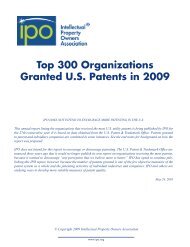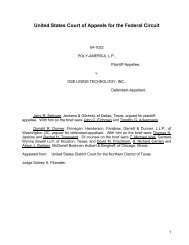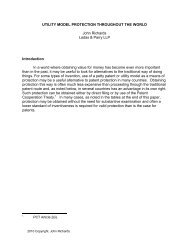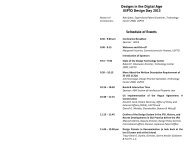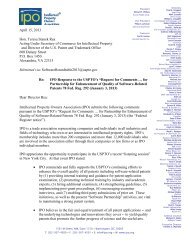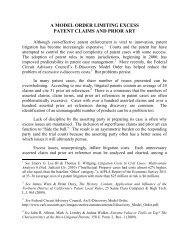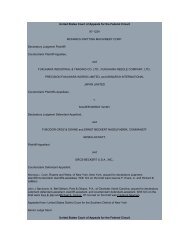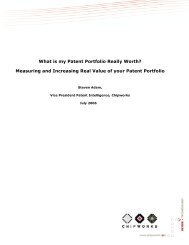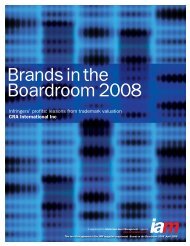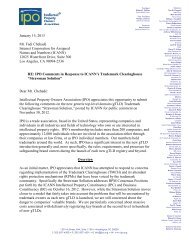State Contracting & Engineering Corp. v. State of Florida Dept. of ...
State Contracting & Engineering Corp. v. State of Florida Dept. of ...
State Contracting & Engineering Corp. v. State of Florida Dept. of ...
You also want an ePaper? Increase the reach of your titles
YUMPU automatically turns print PDFs into web optimized ePapers that Google loves.
United <strong>State</strong>s Court <strong>of</strong> Appeals for the Federal Circuit<br />
00-1434<br />
STATE CONTRACTING & ENGINEERING CORPORATION<br />
and STATE PAVING CORPORATION,<br />
Plaintiffs-Appellants,<br />
v.<br />
STATE OF FLORIDA, FLORIDA DEPARTMENT OF TRANSPORTATION,<br />
RECCHI AMERICA, INC., THE MURPHY CONSTRUCTION COMPANY,<br />
THE HARDAWAY COMPANY, HUBBARD CONSTRUCTION COMPANY, BALFOUR BEATTY<br />
CONSTRUCTION, INC.,<br />
COMMUNITY ASPHALT CORPORATION,<br />
and JOELSON CONCRETE PIPE COMPANY, INC.,<br />
Defendants-Appellees.<br />
Richard S. Ross, <strong>of</strong> Ft. Lauderdale, <strong>Florida</strong>, argued for plaintiffs-appellants.<br />
Stefan V. Stein, Holland & Knight LLP, <strong>of</strong> Tampa, <strong>Florida</strong>, argued for defendants-appellees. Of<br />
counsel was Harvey S. Kauget.<br />
Appealed from: U.S. District Court for the Southern District <strong>of</strong> <strong>Florida</strong><br />
Judge William P. Dimitrouleas<br />
United <strong>State</strong>s Court <strong>of</strong> Appeals for the Federal Circuit<br />
00-1434<br />
STATE CONTRACTING & ENGINEERING CORPORATION
and STATE PAVING CORPORATION,<br />
Plaintiffs-Appellants,<br />
v.<br />
STATE OF FLORIDA, FLORIDA DEPARTMENT OF TRANSPORTATION,<br />
RECCHI AMERICA, INC., THE MURPHY CONSTRUCTION COMPANY,<br />
THE HARDAWAY COMPANY, HUBBARD CONSTRUCTION COMPANY, BALFOUR BEATTY<br />
CONSTRUCTION, INC.,<br />
COMMUNITY ASPHALT CORPORATION,<br />
and JOELSON CONCRETE PIPE COMPANY, INC.,<br />
___________________________<br />
Defendants-Appellees.<br />
DECIDED: JULY 20, 2001<br />
___________________________<br />
Before RADER, GAJARSA, and DYK, Circuit Judges.<br />
DYK, Circuit Judge.<br />
<strong>State</strong> <strong>Contracting</strong> & <strong>Engineering</strong> <strong>Corp</strong>oration (“<strong>State</strong> <strong>Contracting</strong>”) and <strong>State</strong> Paving <strong>Corp</strong>oration<br />
(“<strong>State</strong> Paving”) (collectively “plaintiffs”) appeal the decision <strong>of</strong> the United <strong>State</strong>s District Court for the<br />
Southern District <strong>of</strong> <strong>Florida</strong> granting summary judgment in favor <strong>of</strong> the defendants. <strong>State</strong> <strong>Contracting</strong> & Eng’g<br />
<strong>Corp</strong>. v. <strong>Florida</strong>, No. 97-7014-CIV-DIMITROULEAS (S.D. Fla. Mar. 2, 2000) (“Final Order”). We affirm the<br />
district court’s grant <strong>of</strong> summary judgment to the <strong>State</strong> <strong>of</strong> <strong>Florida</strong> as to the patent infringement and Lanham<br />
Act claims (counts I, II, IV) on grounds <strong>of</strong> sovereign immunity. We also affirm the district court’s grant <strong>of</strong><br />
summary judgment to the <strong>State</strong> <strong>of</strong> <strong>Florida</strong> as to the takings claim (count V) and the breach <strong>of</strong> contract claim<br />
(count VI). However, we hold that the district court erred in granting summary judgment to the private<br />
contractors on the patent infringement claims (counts III and VII), and therefore we vacate and remand as to<br />
these claims. Accordingly, we affirm in part, vacate in part, and remand.<br />
BACKGROUND<br />
In 1989, <strong>State</strong> Paving <strong>Corp</strong>oration, a highway construction company, successfully bid on a <strong>State</strong> <strong>of</strong><br />
<strong>Florida</strong> Department <strong>of</strong> Transportation (“FDOT” or “<strong>State</strong> <strong>of</strong> <strong>Florida</strong>”) project for construction <strong>of</strong> sound barrier<br />
walls. The original agreement was reduced to writing and expressly incorporated the FDOT Standard<br />
Specifications for Road and Bridge Construction (“Standard Specifications”). During the course <strong>of</strong> the<br />
construction, <strong>State</strong> Paving submitted a Value <strong>Engineering</strong> Change Proposal (“VECP”) proposing to use a<br />
new design for sound walls that would reduce costs. The new sound wall design described in the VECP
allegedly included the use <strong>of</strong> a post (column) positioned in a cement-filled pile using a new method devised<br />
by <strong>State</strong> Paving which was particularly suitable for use in sandy soil. FDOT accepted the VECP on July 5,<br />
1990, agreeing to change the specifications <strong>of</strong> the contract to include the use <strong>of</strong> the sound wall design<br />
described in the VECP. The “Supplemental Agreement” signed by the parties stated that the contract<br />
adjustment and sum agreed to “constitutes a full and complete settlement” and that <strong>State</strong> Paving “accepts<br />
the terms <strong>of</strong> this Supplemental Agreement as full compensation for all costs <strong>of</strong> equipment, manpower,<br />
materials, overhead, pr<strong>of</strong>it and delay damages and for all their costs, whether direct or indirect, or whether<br />
incurred now or in the future, related to the issues set forth in this Agreement.” Pursuant to the contract and<br />
“Supplemental Agreement,” the <strong>State</strong> <strong>of</strong> <strong>Florida</strong> paid <strong>State</strong> Paving fifty percent <strong>of</strong> the cost savings realized<br />
by the VECP.<br />
On June 29, 1990, <strong>State</strong> Paving filed a patent application with the United <strong>State</strong>s Patent and<br />
Trademark Office for a structure and method using the technology described in the VECP. The application<br />
matured into two U.S. patents: (1) Patent No. 5,234,288 (the “’288 patent”), issued on August 10, 1993,<br />
directed to an improved method <strong>of</strong> forming a post by inserting the post into a cement slurry pile which is<br />
particularly suitable for use in building structures in sandy soil; and (2) Patent No. 5,429,455 (the “’455<br />
patent”), issued on July 4, 1995, directed to the structure <strong>of</strong> the post and cement pile.[1]<br />
FDOT began using data from the VECP in subsequent requests for bids. <strong>State</strong> Paving learned about one <strong>of</strong><br />
these instances in September 1992 and sent a letter to potential bidders, advising them <strong>of</strong> the pending<br />
patent application and seeking a patent royalty. <strong>State</strong> Paving also sought additional payments under the<br />
contract for its use <strong>of</strong> the VECP data in other contracts to which <strong>State</strong> Paving was not a party.<br />
The issues were not resolved by negotiation, and in August 1997 <strong>State</strong> Paving and <strong>State</strong> <strong>Contracting</strong><br />
(collectively “<strong>State</strong> <strong>Contracting</strong>” or “plaintiffs”) brought the present lawsuit against the <strong>State</strong> <strong>of</strong> <strong>Florida</strong> and<br />
seven private contractors in the United <strong>State</strong>s District Court for the Southern District <strong>of</strong> <strong>Florida</strong>.<br />
The plaintiffs filed a seven-count amended complaint on June 5, 1998, asserting the following claims: (1)<br />
direct patent infringement by the <strong>State</strong> <strong>of</strong> <strong>Florida</strong> <strong>of</strong> the ’288 patent directed to the method <strong>of</strong> forming the<br />
improved post and cement pile (count I); (2) direct patent infringement by the <strong>State</strong> <strong>of</strong> <strong>Florida</strong> <strong>of</strong> the ’455<br />
patent directed to the structure <strong>of</strong> the improved post and cement pile (count II); (3) direct patent infringement<br />
by private highway construction contractors which worked for the <strong>State</strong> <strong>of</strong> <strong>Florida</strong> for infringement <strong>of</strong> both<br />
patents (count III); (4) violations <strong>of</strong> the Lanham Act by the <strong>State</strong> <strong>of</strong> <strong>Florida</strong> for its representation to potential<br />
bidders <strong>of</strong> construction projects that the specified method for sandy soil construction was “unpatented”<br />
(count IV); (5) unconstitutional taking by the <strong>State</strong> <strong>of</strong> <strong>Florida</strong> <strong>of</strong> plaintiffs’ proprietary and patent rights in<br />
designs and specifications for the construction <strong>of</strong> sound barrier walls (count V); (6) breach <strong>of</strong> contract by the<br />
<strong>State</strong> <strong>of</strong> <strong>Florida</strong> for failure to compensate plaintiffs under the contract for use <strong>of</strong> plaintiff’s proprietary<br />
technology on sound barrier construction projects after the original contract with plaintiffs (count VI); and (7)<br />
contributory patent infringement by Joelson Concrete Pipe Company based on its manufacture, use and<br />
sale <strong>of</strong> posts specially made as a component <strong>of</strong> the patented apparatus and method (count VII).<br />
On June 22, 1998, the defendants answered the amended complaint as to all counts except for the Lanham<br />
Act claims, which the <strong>State</strong> <strong>of</strong> <strong>Florida</strong> moved to dismiss on grounds <strong>of</strong> sovereign immunity. In the answer,<br />
the defendants counterclaimed for a declaratory judgment <strong>of</strong> non-infringement and invalidity <strong>of</strong> the ’288 and<br />
’455 patents. The district court denied the <strong>State</strong> <strong>of</strong> <strong>Florida</strong>’s motion to dismiss the Lanham Act count. That<br />
decision was appealed to this court. We remanded the case to the district court to “consider all issues that<br />
may be before the court in the first instance” in light <strong>of</strong> the Supreme Court’s decisions in <strong>Florida</strong> Prepaid<br />
Postsecondary Education Expense Board v. College Savings Bank, 527 U.S. 627 (1999), and College Savings<br />
Bank v. <strong>Florida</strong> Prepaid Postsecondary Education Expense Board, 527 U.S. 666 (1999).[2] <strong>State</strong> <strong>Contracting</strong> &<br />
Eng’g <strong>Corp</strong>. v. <strong>Florida</strong>, No. 99-1236, 1999 WL 717798 (Fed. Cir. Sept. 2, 1999) (nonprecedential order).<br />
On remand, the parties filed cross motions for summary judgment. In the final order <strong>of</strong> March 2, 2000, the<br />
district court dismissed counts I, II, and IV (which stated claims against the <strong>State</strong> <strong>of</strong> <strong>Florida</strong> for patent<br />
infringement and violation <strong>of</strong> the Lanham Act) on grounds <strong>of</strong> sovereign immunity. The court also granted<br />
summary judgment to the <strong>State</strong> <strong>of</strong> <strong>Florida</strong> on count V -- the takings claims. The court granted summary<br />
judgment on count VI (seeking recovery against the <strong>State</strong> <strong>of</strong> <strong>Florida</strong> under the contract) against <strong>State</strong><br />
<strong>Contracting</strong> on the ground that the contract had not been breached. Finally, the court granted summary<br />
judgment on counts III and VII (patent infringement) to the private contractors on the ground that the contract<br />
with the <strong>State</strong> created a license to practice the patent. The court failed to expressly address the defendants’
counterclaims for a declaratory judgment <strong>of</strong> non-infringement and invalidity <strong>of</strong> the ’288 and ’455 patents in<br />
the March 2, 2000, final order. <strong>State</strong> <strong>Contracting</strong> appealed to this court.<br />
DISCUSSION<br />
I. Standard <strong>of</strong> Review<br />
We follow the regional circuit’s standard <strong>of</strong> review regarding issues not pertaining to patent law. Coll. Sav.<br />
Bank v. Fla. Prepaid Postsecondary Educ. Expense Bd., 148 F.3d 1343, 1346, 47 USPQ2d 1161, 1163 (Fed.<br />
Cir. 1998), rev’d on other grounds, 527 U.S. 627 (1999); Molins PLC v. Quigg, 837 F.2d 1064, 1066, 5<br />
USPQ2d 1526, 1527 (Fed. Cir. 1988). Under the law <strong>of</strong> the Eleventh Circuit, we review without deference a<br />
district court’s ruling on the issue <strong>of</strong> sovereign immunity to suit. Fla. Paraplegic Assoc., Inc. v. Miccosukee<br />
Tribe <strong>of</strong> Indians <strong>of</strong> Fla., 166 F.3d 1126, 1128 (11th Cir. 1999); Tinney v. Shores, 77 F.3d 378, 383 (11th Cir.<br />
1996). We review a district court’s grant <strong>of</strong> summary judgment without deference. Ethicon Endo-Surgery,<br />
Inc. v. United <strong>State</strong>s Surgical <strong>Corp</strong>., 149 F.3d 1309, 1315, 47 USPQ2d 1272, 1275 (Fed. Cir. 1998).<br />
II.<br />
Jurisdiction/Finality <strong>of</strong> Judgment<br />
Before addressing the merits, we are obligated to consider the issue <strong>of</strong> our jurisdiction. Bender v.<br />
Williamsport Area Sch. Dist., 475 U.S. 534, 541 (1986) (“[E]very federal appellate court has a special<br />
obligation to satisfy itself . . . <strong>of</strong> its own jurisdiction.”) (internal quotations and citations omitted); see<br />
also Helfgott & Karas, P.C. v. Dickenson, 209 F.3d 1328, 1333, 54 USPQ2d 1425, 1428 (Fed. Cir. 2000). At<br />
the time the plaintiffs appealed to this Court, there remained pending in the district court the counterclaims<br />
directed toward non-infringement and patent invalidity. Since it appeared that there might be no appealable<br />
final judgment and no certification pursuant to Fed. R. Civ. P. 54(b), on June 7, 2001, we issued an order<br />
directing the parties to address the jurisdictional issue. The parties agreed that the judgment <strong>of</strong> the district<br />
court was not final because <strong>of</strong> the pending counterclaims and that no Rule 54(b) certification had been<br />
entered, but filed in the district court an “Emergency Motion/Request for Certification <strong>of</strong> Final Order <strong>of</strong><br />
Summary Judgment for Defendants Pursuant to Rule 54(b).”<br />
On June 20, 2001, the district court issued an order granting plaintiffs’ request for a certification <strong>of</strong> final<br />
judgment, <strong>State</strong> <strong>Contracting</strong> & <strong>Engineering</strong> <strong>Corp</strong>. v. <strong>Florida</strong>, No. 97-7014-CIV-DIMITROULEAS (S.D. Fla. June<br />
20, 2001) (Order Amending Order <strong>of</strong> March 2, 2000 and Granting Motion For Certification), stating that<br />
“there is no just reason for delay <strong>of</strong> the appeal <strong>of</strong> the March 2, 2000 Order,” id., slip op. at 2, and that “the<br />
Court intended the March 2, 2000 Order to be final as to all <strong>of</strong> Plaintiffs’ claims.” Id. The district court also<br />
amended the March 2, 2000, order “to add numbered paragraph 12 on page 14, stating: ‘Defendants’<br />
counterclaims in this case are hereby DISMISSED as moot, without prejudice, and may be reinstated in the<br />
event the Federal Circuit Court <strong>of</strong> Appeals reverses or remands this case back to this Court.” Id. at 2-3. By<br />
separate order also dated June 20, 2001, the district court ordered that “summary final judgment is hereby<br />
entered,nunc pro tunc to March 2, 2000, on behalf <strong>of</strong> all Defendants as to all counts <strong>of</strong> Plaintiffs’ amended<br />
complaint, and against the Plaintiffs, and Plaintiffs shall take nothing by this action.” <strong>State</strong> <strong>Contracting</strong> &<br />
Eng’g <strong>Corp</strong>. v. <strong>Florida</strong>, No. 97-7014-CIV-DIMITROULEAS (S.D. Fla. June 20, 2001) (Final Summary<br />
Judgment).<br />
Under these circumstances we conclude that we have jurisdiction because the district court’s order<br />
constitutes a final judgment under Rule 54(b). See 10 Charles Alan Wright & Arthur R. Miller, Federal<br />
Practice and Procedure § 2660 (3d ed. 1998). We have established that in matters <strong>of</strong> our own jurisdiction,<br />
regional circuit law is not binding, and we are obligated to make an independent determination <strong>of</strong> our<br />
jurisdiction. Woodard v. Sage Prods., Inc., 818 F.2d 841, 844, 2 USPQ2d 1649, 1651 (Fed. Cir. 1987) (noting<br />
that “deference [to regional circuit law] is inappropriate on issues <strong>of</strong> our own appellate jurisdiction,” and that<br />
“our decision to follow another circuit’s interpretation <strong>of</strong> a common jurisdictional statute results from the<br />
persuasiveness <strong>of</strong> its analysis, not any binding effect”); see also Slip Track Sys., Inc. v. Metal Lite, Inc., 159<br />
F.3d 1337, 1339, 48 USPQ2d 1055, 1056 (Fed. Cir. 1998); Enercon Indus. <strong>Corp</strong>. v. Pillar <strong>Corp</strong>., 105 F.3d<br />
1437, 1439 n.2, 41 USPQ2d 1630, 1631 n.2 (Fed. Cir. 1997). We have specifically held that Federal Circuit<br />
law applies to Rule 54(b) certification and appellate jurisdiction issues. Enercon Indus., 105 F.3d at 1439 n.2,<br />
41 USPQ2d at 1631 n.2; Spraytex, Inc., v. DJS&T, 96 F.3d 1377, 1379, 40 USPQ2d 1145, 1146 (Fed.<br />
Cir. 1996). We elect to follow the majority <strong>of</strong> other circuits and hold that a premature notice <strong>of</strong> appeal ripens<br />
upon entry <strong>of</strong> a proper Rule 54(b) certification. See, e.g., Clausen v. Sea-3, 21 F.3d 1181, 1184 (1st Cir.<br />
1994) (“The majority <strong>of</strong> circuits that have addressed jurisdictional quagmires similar to this one have held
that a belated Fed. R. Civ. P. 54(b) certification ripens a premature notice <strong>of</strong> appeal as <strong>of</strong> the date <strong>of</strong> the<br />
certification.”); Good v. Ohio Edison Co., 104 F.3d 93, 95 (6th Cir. 1997) (stating that its holding that “a<br />
premature notice <strong>of</strong> appeal ripens upon the entry <strong>of</strong> a proper Rule 54(b) certification, regardless <strong>of</strong> whether<br />
the certification is entered nunc pro tunc. . . . is consistent with a majority <strong>of</strong> our sister circuits that have<br />
addressed this issue”). But see Useden v. Acker, 947 F.2d 1563, 1570 (11th Cir. 1991), cert. denied, 508 U.S.<br />
959 (1993). We follow the majority view and hold that the June 20, 2001, Rule 54(b) certification relates<br />
back to the March 2, 2000, final order, and that we have appellate jurisdiction.<br />
III.<br />
Sovereign Immunity<br />
A. Patent Infringement and Lanham Act Claims (Counts I, II, and IV)<br />
On the issue <strong>of</strong> sovereign immunity, this case is governed by <strong>Florida</strong> Prepaid Postsecondary Education<br />
Expense Board v. College Savings Bank, 527 U.S. 627 (1999), and College Savings Bank v. <strong>Florida</strong> Prepaid<br />
Postsecondary Education Expense Board, 527 U.S. 666 (1999). In those cases, the Supreme Court<br />
established the Eleventh Amendment immunity <strong>of</strong> states from, respectively, patent infringement suits under<br />
the patent statute and unfair competition suits under the Lanham Act. In<strong>Florida</strong> Prepaid, 527 U.S. 627, the<br />
Supreme Court held that although Congressional intent to abrogate states’ immunity for patent infringement<br />
claims was unmistakably clear in the language <strong>of</strong> the Patent and Plant Variety Protection Remedy<br />
Clarification Act (Patent Remedy Act), the Commerce Clause, the Patent Clause, and the 14th Amendment<br />
did not provide Congress with authority to abrogate state sovereign immunity with respect to patent<br />
infringement claims. Id. at 636-48. Accordingly, the Supreme Court reversed this court’s decision in College<br />
Savings Bank v. <strong>Florida</strong> Prepaid Postsecondary Education Expense Board, 148 F.3d 1343 (Fed. Cir. 1998),<br />
which had sustained the abrogation <strong>of</strong> immunity. 527 U.S. at 648. In the companion case at the Supreme<br />
Court, College Savings Bank, 527 U.S. 666, 672-75, the Court held that the Trademark Remedy Clarification<br />
Act did not abrogate sovereign immunity for actions brought under the Lanham Act. The Court also held<br />
that <strong>Florida</strong> did not voluntarily waive its sovereign immunity through its activities in interstate commerce and<br />
expressly overruled the Court’s previous decision in Parden v. Terminal Railway <strong>of</strong> Alabama <strong>State</strong> Docks<br />
Department, 377 U.S. 184 (1964), which had recognized an implied or constructive waiver <strong>of</strong> sovereign<br />
immunity. 527 U.S. at 675-87. The Supreme Court affirmed the Third Circuit decision in College Savings<br />
Bank v. <strong>Florida</strong> Prepaid Postsecondary Education Expense Board, 131 F.3d 353, 366 (3d Cir. 1997). 527 U.S.<br />
at 691.<br />
Under the Court’s decisions in College Savings Bank and <strong>Florida</strong> Prepaid, <strong>Florida</strong> enjoys sovereign immunity<br />
with respect to the patent infringement and Lanham Act claims unless <strong>Florida</strong> has waived sovereign<br />
immunity. The district court rejected <strong>State</strong> <strong>Contracting</strong>’s assertion that <strong>Florida</strong> has waived its immunity<br />
either generally or specifically by participating in the litigation. On this appeal, plaintiffs contest the district<br />
court’s waiver decision.<br />
We are not persuaded that <strong>Florida</strong> has generally waived its immunity to suit. The <strong>Florida</strong> Supreme Court’s<br />
1941 decision in <strong>State</strong> Road Department <strong>of</strong> <strong>Florida</strong> v. Tharp, 1 So. 2d 868 (Fla. 1941), held merely that a bill <strong>of</strong><br />
complaint for an injunction against the <strong>State</strong> <strong>of</strong> <strong>Florida</strong> in state court on a theory <strong>of</strong> trespass could be<br />
maintained because the state had waived immunity by state statute and by the <strong>Florida</strong> Constitution. The<br />
case may also represent a holding that sovereign immunity is waived as to takings claims in state<br />
court. The question, however, remains whether <strong>Florida</strong> has waived sovereign immunity in this particular<br />
case as to the patent and Lanham Act claims in the federal district court. It is well-established that an<br />
express waiver <strong>of</strong> sovereign immunity must be unequivocal. Coll. Sav. Bank, 527 U.S. at 680; Pennhurst<br />
<strong>State</strong> Sch. & Hosp. v. Halderman, 465 U.S. 89, 99 (1984); Great N. Life Ins. Co. v. Read, 322 U.S. 47, 54<br />
(1944). After College Savings Bank, it is clear that any waiver <strong>of</strong> sovereign immunity by a state must be<br />
express and voluntary, and cannot be implied or constructive. 527 U.S. at 682 (expressly<br />
overruling Parden). The Court also emphasized that the test for finding an express waiver is a stringent<br />
one. Coll. Sav. Bank, 527 U.S. at 682. Under this standard we cannot find a general waiver <strong>of</strong> immunity with<br />
respect to Lanham Act and patent claims.
<strong>State</strong> <strong>Contracting</strong> also claims that <strong>Florida</strong> has waived its sovereign immunity by defending this litigation, both<br />
on its own behalf and as the representative <strong>of</strong> the alleged private infringers. It is quite clear that those<br />
activities do not amount to a waiver. In <strong>Florida</strong> Department <strong>of</strong> <strong>State</strong> v. Treasure Salvors, Inc., 458 U.S. 670,<br />
683 n.18 (1982), for example, the Supreme Court held that “[t]he fact that the <strong>State</strong> appeared and <strong>of</strong>fered<br />
defenses on the merits does not foreclose consideration <strong>of</strong> the Eleventh Amendment issue.” See<br />
also Allinder v. Ohio, 808 F.2d 1180, 1184 (6th Cir. 1987) (holding that the <strong>State</strong> <strong>of</strong> Ohio did not waive<br />
immunity by generally defending itself when it raised defenses in addition to sovereign immunity).<br />
In its answer to the amended complaint, the <strong>State</strong> <strong>of</strong> <strong>Florida</strong> counterclaimed for a declaratory<br />
judgment <strong>of</strong> non-infringement and invalidity <strong>of</strong> the ’288 and ’455 patents. <strong>State</strong> <strong>Contracting</strong> next asserts that<br />
<strong>Florida</strong> has waived immunity as to the patent claims by filing the counterclaim and by litigating the<br />
counterclaim. The question whether the filing <strong>of</strong> a counterclaim constitutes a waiver <strong>of</strong> immunity as to the<br />
patent claims is substantial, for some courts have suggested that the filing <strong>of</strong> a counterclaim waives<br />
immunity, see, e.g., Paul N. Howard Co. v. Puerto Rico Aqueduct Sewer Authority, 744 F.2d 880, 886 (1st Cir.<br />
1984), Newfield House, Inc. v. Massachusetts Department <strong>of</strong> Public Welfare, 651 F.2d 32, 36 n.3 (1st Cir.<br />
1981), and others have made clear that the filing <strong>of</strong> a patent counterclaim <strong>of</strong> invalidity is quite a separate<br />
matter from asserting affirmative defenses <strong>of</strong> invalidity, Cardinal Chem. Co. v. Morton Int’l, Inc., 508 U.S. 83,<br />
94 (1993) (discussing differences between filing an answer asserting invalidity and filing a counterclaim for<br />
declaratory judgment <strong>of</strong> invalidity). In College Savings Bank, 131 F.3d 353, 366 (3d Cir. 1997), aff’d, 527 U.S.<br />
666 (1999), the Third Circuit held that <strong>Florida</strong>’s filing <strong>of</strong> a Lanham Act counterclaim did not waive its defense<br />
<strong>of</strong> sovereign immunity because it was not until the Supreme Court decision in Seminole Tribe <strong>of</strong> <strong>Florida</strong> v.<br />
<strong>Florida</strong>, 517 U.S. 44 (1996), that “the successful assertion <strong>of</strong> an immunity defense became a reasonable<br />
possibility.” In Seminole Tribe, the Supreme Court first held that Congress’ authority to abrogate a state’s<br />
Eleventh Amendment immunity from suit in federal court was confined to the enforcement section <strong>of</strong> the<br />
Fourteenth Amendment. We generally agree with the Third Circuit’s approach, with two modifications. We<br />
think that the test should be one <strong>of</strong> “reasonable expectation” rather than “reasonable possibility,” thus<br />
allowing some greater latitude for the filing <strong>of</strong> protective counterclaims by the states without waiving<br />
immunity, and we conclude that the decision in Seminole Tribe did not create a reasonable expectation that<br />
the state would prevail on its sovereign immunity claim with respect to the patent infringement counts.<br />
In this case, the patent counterclaim was filed on June 22, 1998. At the time the counterclaim was filed<br />
Congress had abrogated the state’s patent infringement immunity in the 1994 Patent Remedy Act, and we<br />
sustained the abrogation <strong>of</strong> immunity for patent infringement claims on June 30, 1998, in our College Savings<br />
Bank decision, 148 F.3d 1343 (Fed. Cir. 1998), shortly after the counterclaim was filed. The <strong>State</strong> <strong>of</strong> <strong>Florida</strong><br />
could not have reasonably expected to prevail on its sovereign immunity defense until <strong>Florida</strong> Prepaid was<br />
decided by the Supreme Court. Therefore, it was entirely reasonable for the <strong>State</strong> to file a counterclaim <strong>of</strong><br />
patent invalidity.[3] In short, we agree that the filing <strong>of</strong> a counterclaim during a period when the <strong>State</strong> was<br />
reasonably unsure about the availability <strong>of</strong> an immunity defense was not a waiver. The parties agree that<br />
<strong>Florida</strong> took no further action on the counterclaims after the Supreme Court’s decision in <strong>Florida</strong> Prepaid. We<br />
hold that <strong>Florida</strong>’s mere failure to withdraw the counterclaims after the Supreme Court decision cannot be a<br />
waiver <strong>of</strong> sovereign immunity as to counts I, II, and IV.<br />
B. Takings Claim (Count V)<br />
In its complaint, plaintiffs alleged an unconstitutional taking by the <strong>State</strong> <strong>of</strong> <strong>Florida</strong> <strong>of</strong> their proprietary and<br />
patent rights in designs and specifications for the construction <strong>of</strong> sound barrier walls. The district court held<br />
that the takings claim was barred by sovereign immunity because “[a]llowing Plaintiffs’ Count V to proceed<br />
would vitiate the Eleventh Amendment analysis in the Supreme Court’s College Savings Bank opinions by<br />
turning every patent infringement case against a state into a Section 1983 takings case for patent<br />
pr<strong>of</strong>its.” Id., slip op. at 9. We affirm the holding <strong>of</strong> sovereign immunity, but on a different ground. In Quern v.<br />
Jordan, 440 U.S. 332, 345 (1979), the Supreme Court recognized that 42 U.S.C. § 1983 did not abrogate the<br />
states’ sovereign immunity for suits in federal court. The Court noted that “[Section] 1983 does not explicitly<br />
and by clear language indicate on its face an intent to sweep away the immunity <strong>of</strong> the <strong>State</strong>s; nor does it<br />
have a history which focuses directly on the question <strong>of</strong> state liability and which shows that Congress<br />
considered and firmly decided to abrogate the Eleventh Amendment immunity <strong>of</strong> the <strong>State</strong>s.” Id. In light<br />
<strong>of</strong> Quern, we affirm the district court’s grant <strong>of</strong> summary judgment in favor <strong>of</strong> the <strong>State</strong> <strong>of</strong> <strong>Florida</strong> on the<br />
takings claim.<br />
C. Breach <strong>of</strong> Contract against the <strong>State</strong> <strong>of</strong> <strong>Florida</strong> (Count VI)
The district court assumed that there was no sovereign immunity as to claims against the <strong>State</strong> <strong>of</strong> <strong>Florida</strong> for<br />
breach <strong>of</strong> contract, and the parties apparently agree, as do we. But the district court also correctly held that<br />
the contract claims against <strong>Florida</strong> were without merit. Final Order, slip op. at 9-12. Plaintiffs argue that the<br />
contract obligated FDOT to compensate plaintiffs for the cost savings in future contracts using the plaintiff’s<br />
proprietary technology at the same rate as in the VECP contract. Id., slip op. at 10.<br />
The relevant portions <strong>of</strong> the contract on this issue are found in the FDOT Standard Specifications that are<br />
expressly incorporated into the contract. Section 4-3.5.7, entitled “Sharing Arrangements,” states:<br />
If a VECP is accepted by the Department, the Contractor is entitled to share in instant contract savings . . .<br />
. For the purposes <strong>of</strong> sharing under this Subarticle, the term ‘instant contract’ . . . . shall, however, include<br />
any extension <strong>of</strong> the instant contract through exercise <strong>of</strong> an option (if any) provided under this Contract after<br />
acceptance <strong>of</strong> the VECP.<br />
. . .<br />
The Contractor shall not receive instant savings or collateral savings shares on optional work listed in this<br />
Contract, until the Department exercises its option to obtain that work.<br />
(emphases added).<br />
We agree with the district court that this language is unambiguous, and that the obligation is limited<br />
to “optional work listed in this Contract” or work under “an option (if any) provided under this Contract.” The<br />
work in question was not option work under the original contract. We agree with the district court that this<br />
language did not create an obligation to pay plaintiffs if FDOT used their data on future contracts as plaintiffs<br />
claim here. Contrary to appellants’ arguments, Dahl-Eimers v. Mutual <strong>of</strong> Omaha Life Insurance Co., 986 F.2d<br />
1379, 1381 (11th Cir. 1993), and Davis v. Crown Life Insurance Co., 696 F.2d 1343, 1346 (11th Cir. 1983), do<br />
not establish that the absence <strong>of</strong> a provision for payment renders a contract ambiguous under <strong>Florida</strong> law.<br />
IV.<br />
Claims Against Private Contractors for Patent Infringement (Counts III and VII)<br />
This leads us to the claims against the private parties. The district court reasoned that the patent<br />
infringement claims against the private contractors (counts III and VII) were barred because <strong>State</strong><br />
<strong>Contracting</strong> had agreed to license the <strong>State</strong> <strong>of</strong> <strong>Florida</strong> under its patents. We conclude that the district court<br />
erred as to these claims.<br />
The contract in question was drafted by the <strong>State</strong> <strong>of</strong> <strong>Florida</strong>, and was lengthy. It incorporated what are<br />
known as value engineering provisions -- designed to encourage contractors to develop better methods <strong>of</strong><br />
doing the job. As noted above, the contract provided for additional payments to the contractor if it developed<br />
such methods and allowed the state to use these methods on the contract and on option contracts free <strong>of</strong><br />
charge.<br />
The relevant portion <strong>of</strong> the contract, section 4-3.5.8 <strong>of</strong> the FDOT Standard Specifications, entitled<br />
“Department’s Future Rights to a VECP,” provided:<br />
In the event <strong>of</strong> acceptance <strong>of</strong> a VECP, the Contractor hereby grants to the Department all rights to use,<br />
duplicate or disclose, in whole or in part, in any manner and for any purpose whatsoever, and to have or to<br />
permit others to do so, data reasonably necessary to fully utilize such proposal on this and any other<br />
Department contract.
(emphases added). These provisions were not limited to the contract in question, but extended to all future<br />
<strong>State</strong> <strong>of</strong> <strong>Florida</strong> use. The district court found this language to be unambiguous and held that “Plaintiffs<br />
agreed in the VECP to allow FDOT to utilize their then unpatented data, without any agreement to<br />
compensate Plaintiffs for future use, beyond the instant contract savings and any optional work included in<br />
the original contract.” Final Order, slip op. at 12-13. While we agree with the district court that this language<br />
is unambiguous, we disagree with the district court’s interpretation <strong>of</strong> this language. We conclude that the<br />
contract does not provide a license for patent rights to the private contractors.<br />
“Whether express or implied, a license is a contract ‘governed by ordinary principles <strong>of</strong> state contract<br />
law.’” McCoy v. Mitsuboshi Cutlery, Inc., 67 F.3d 917, 920 36 USPQ2d 1289, 1291 (Fed. Cir. 1995)<br />
(quoting Power Lift, Inc. v. Weatherford Nipple-Up Sys., Inc., 871 F.2d 1082, 1085, 10 USPQ2d 1464, 1466<br />
(Fed. Cir. 1989)). Although we apply <strong>Florida</strong> law in construing the contract, it is significant that the Supreme<br />
Court has recognized that patent rights and trade secret rights are quite distinct, and that a contract may<br />
provide for different treatment <strong>of</strong> the two. For example, in Aronson v. Quick Point Pencil Co., 440 U.S. 257,<br />
262 (1979), the Supreme Court held that even though a patent application had not issued, the parties’<br />
agreement for the payment <strong>of</strong> a royalty for the use <strong>of</strong> proprietary technology was valid, because “[s]tate law<br />
is not displaced merely because the contract relates to intellectual property which may or may not be<br />
patentable.” So too inKewanee Oil Co. v. Bicron <strong>Corp</strong>., 416 U.S. 470, 474, 491-93 (1974), the Supreme Court<br />
held that Ohio’s law protecting trade secrets was not preempted by the federal patent laws because the<br />
trade secret law did not clash with the objectives <strong>of</strong> the federal patent law.<br />
The right to use <strong>State</strong> <strong>Contracting</strong>’s proprietary technology on the original contract was covered by the<br />
supplemental VECP agreement itself as discussed above. The only rights that the state acquired for future<br />
contracts were by virtue <strong>of</strong> section 4-3.5.8. To be sure, the provision apparently contemplated that <strong>State</strong><br />
<strong>Contracting</strong>’s “proposal” would be used on “other Department contract[s].” But that section only conveyed<br />
rights to use “data” in future contracts, and did not in terms convey the right to manufacture the sound<br />
barriers using plaintiffs’ design or to use plaintiffs’ manufacturing method. Most significantly the section did<br />
not explicitly convey any patent rights, require the contractor to surrender its rights to the technology, or bar<br />
the contractor from securing a patent on the invention.<br />
The contract’s failure to explicitly provide for the licensing <strong>of</strong> patent rights is a glaring omission, particularly<br />
where, as here, the contracting parties clearly contemplated that there might be relevant patents. Section 7-<br />
3 <strong>of</strong> the FDOT Standard Specifications, entitled “Patented Devices, Materials and Processes,” provides: “It<br />
is agreed that, without exception, contract prices are to include all royalties and costs arising from patents,<br />
trademarks, and copyrights, in any way involved in the work.” The provision for licensing <strong>of</strong> patents is<br />
limited to work under the contract and does not convey any license to future use <strong>of</strong> the patented<br />
technology. The existence <strong>of</strong> this provision shows that, if the parties had intended to convey other patent<br />
rights, they would have done so explicitly.<br />
Under these circumstances we think it clear that the contract did not in fact provide a license for<br />
patent rights to the private contractors under future contracts. The <strong>State</strong> <strong>of</strong> <strong>Florida</strong> drafted the contract, and<br />
<strong>Florida</strong> law requires that it be construed against the drafter. Golden Door Jewelry Creations, Inc. v. Lloyds<br />
Underwriters Non-Marine Ass’n, 117 F.3d 1328 (11th Cir. 1997). Therefore, we vacate the district court’s<br />
grant <strong>of</strong> summary judgment to the private contractors on the patent infringement counts (counts III and VII),<br />
and remand for proceedings consistent with this opinion.<br />
CONCLUSION<br />
Based on the above, we affirm in part, vacate in part, and remand. We hold that the district court did<br />
not err in granting summary judgment to the <strong>State</strong> <strong>of</strong> <strong>Florida</strong> on counts I, II, IV, V, and VI, but that the district<br />
court erred in granting summary judgment to the private contractors on counts III and VII.<br />
AFFIRMED-IN-PART, VACATED-IN-PART, and REMANDED.<br />
COSTS<br />
No costs.
[1] <strong>State</strong> Paving assigned its rights under the patents to <strong>State</strong> <strong>Contracting</strong>.<br />
[2] Both cases involved a private party, College Savings Bank, and a state agency, <strong>Florida</strong> Prepaid<br />
Postsecondary Education Expense Board. The cases involve somewhat similar facts and were issued on<br />
the same day by the Supreme Court.<br />
[3] The district court noted that “the state <strong>of</strong> the law at the time Defendants filed their answer,<br />
counterclaim and motion to dismiss, was clear that a state could be sued for patent infringement under the<br />
Patent and Plant Protection Remedy Clarification Act as enacted by Congress.” Final Order, slip op. at 6-7<br />
(emphasis in original).



